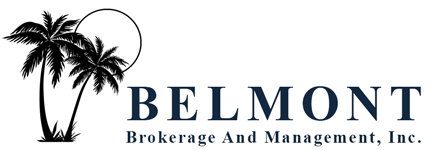The Employees at Belmont Brokerage & Management, Inc. believe in the principals of Quality Control. Following these principals on a consistent basis insures we provide the professionalism required to manage our client’s properties—
THIS IS WHAT WE BELIEVE:
The Customer is King
In today’s buyer’s market, the customer is king. What your customer wants is value. Value. That’s a key word. It stands for quality and reliability at a reasonable price. In the competitive market it is imperative that each employee understands the importance of the customer.
Customers are:
- The most important people in any business
- Not dependent on us. We are dependent on them.
- Not an interruption of our work. They are the purpose of it.
- Doing us a favor when they come in. We are not doing them a favor by servicing them.
- A part or our business, not outsiders.
- Not just a statistic. They are flesh-and-blood human beings with feelings and emotions, like ourselves.
- People who come to us with their needs and wants. It is our job to fill them.
- Deserving of the most courteous and attentive treatment we can give them.
- The lifeblood of this and every other business. Without them we would have to close our doors.
Good Enough is not Good Enough:
- We can no longer live with the defect levels we have accepted in the past.
- Our company needs to make fewer errors and permit fewer defect.
- Poor training of employees, inferior supervision, and one-way communication must be corrected.
- It is time to stop mediocre performance as acceptable and even as “exceeds expectations” at times.
- One of the very best ways to improve is through improving the excellence of everything we do.
The Improvement Process:
- When we stop improving, we start to slip backward.
- We can not say to ourselves: “I’ve always done it this way and it worked, so it must be good enough.”
- Many companies are content with getting by when they should be getting better. Unfortunately, when employees are content, they stop improving.
- The improvement process is a group of activities that complement each other and provide an environment conductive to improving performance for employees and management alike.
Who are our Customers?
- Tenants
- Owners
Most repetitive activities can be considered processes and controlled much
What is Process Management?
- Most repetitive activities can be considered processes and controlled much the same way as manufacturing processes are controlled.
- To help bring this concept into focus, Process is defined as:
- “A series of activities that takes an input, adds value to it, and produces an output.”
- A System is defined as:
- “The controls that are applied to a process to insure that the process is operating efficiently and effectively.”
Four Phases to the Business Process Improvement:
- Definition and Documentation
- Analysis
- Assessment
- Continuous Process Improvement
Phase I: Definition and Documentation
- Develop a flow diagram of the process.
- Establish measurement points and feedback loops.
- Qualify the process
- Develop and implement improvement plans
- Report efficiency, effectiveness, and change status
Measurement Points and Feedback Loops
- After the flowchart is complete, determine the measurement points and feedback loops. Without measurement of the activity, you cannot improve it.
- Three types of measurements in the process:
- Effectiveness-How well the process output meets customer expectations.
- Efficiency—-The way resources, including time, are used to provide output that meets or exceeds customer expectations.
- Adaptability-The ability of the business process to rapidly change or meet an individual, customer, or business need to stay ahead of the changing business environment.
Phase II: Analysis
Some of the items that should be looked at during the analysis phase are discussed below:
- Eliminate No-Value-Added activities (Bureaucracy)
- Self-inspection versus appraisal
- More than one signature
- Writing the same thing twice
- Unnecessary delays
- Redundant tasks
- Simplification
- Combine similar activities
- Reduce amount of handling
- Eliminate unused data
- Clarify forms
- Office layout
- Report layout
- Use simple English
Reduces processing time (look at activities that have long time delays).
- Change activity sequence
- Eliminate wait time
- Reduce interruption
- Improved timing (when employee receives input)
- Reduce output movement
- Set proper priorities
Computerization/mechanization
- Can repetitive, boring activities be automated?
- Which activities can be mechanized or computerized?
- Should the data be handled in a batch or on-line mode?
- Does the employee have the best work layout to accomplish the tasks? (Never start the process improvement activities with computerization or mechanization).
Phase III: Assessment
- Evaluate the process and classify it into one of six categories:
- Unkown-Process status has not been determined
- Understood-process design is understood and operating to its prescribed documentation
- Effective-Process is systematically measured, streamlining has started, and end customer expectations are met.
- Efficient-Process is streamlined and is more efficient
- Error Free-Process is highly effective (error free) and efficient.
- World Class-Process is world class and continuing to improve.
Phase IV: Continuos Process Improvement
The continuous process improvement phase is simplicity itself: Keep doing what your are doing and when everything is going the way it should, withdraw something–pull something out and start over.
Define the Processes
- Tenant Application Process:
- Apartment Rehab
- Rent Collections
- Accounts Payable
- Tenant Repairs
- Building Ongoing Supervision and Maintenance
